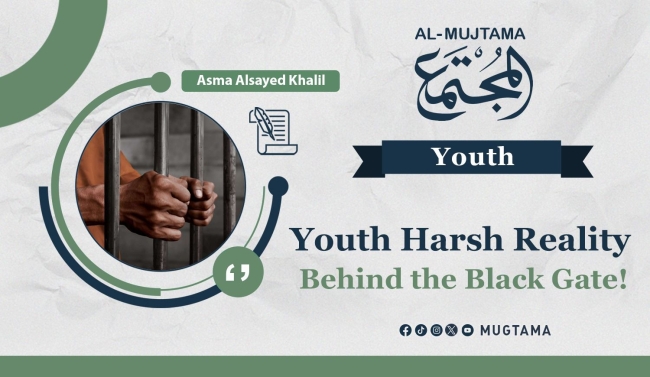Some young people face the painful experience of imprisonment, passing through the so-called “Black Gate,” symbolizing the grim reality behind it. Once a young person crosses this gate, they enter a different world officially known—euphemistically—as the “Correction and Rehabilitation Authority.” In reality, however, it is a frightening realm where prisoners endure immense suffering, often entering for a minor offense and emerging as hardened criminals.
The reasons leading young people to prison vary, encompassing social, economic, and political factors, pushing them onto the list of offenders. At the forefront are financial crimes, followed by addiction and drug offenses. These issues often stem from poverty, unemployment, and a lack of economic opportunities. Family disintegration and the absence of guardianship also play a role, as does inadequate or absent education. These factors create psychological pressures that may lure individuals toward criminal behavior. In some Arab societies, crimes are even committed for cultural reasons, with some young men resorting to criminal acts as a misguided attempt to assert their masculinity and achieve social prominence.
Deteriorating Prison Conditions
Prisons in several Arab and Muslim countries suffer from dire conditions, prompting local, regional, and international human rights organizations to classify them among the worst in the world. They lack the most basic human rights standards, with reports indicating that 90% of their facilities require demolition and reconstruction to uphold human dignity—even for lawbreakers.
These prisons generally suffer from severe overcrowding, far exceeding their capacity, leading to shortages in essential services such as sleeping spaces and food. They also lack basic hygiene standards, contributing to heightened levels of stress and violence among prisoners. Additionally, there is a notable absence of effective educational and vocational programs and insufficient psychological and social support.
Healthcare inside these prisons is in a miserable state, exacerbating the spread of infectious and chronic diseases. Human rights organizations have documented the prevalence of conditions such as pulmonary tuberculosis, liver and spleen enlargement, stomach ulcers, herniated discs, bone and spinal pain, as well as hearing and vision impairments. The situation is no better for women and juvenile inmates, who face similar overcrowding, medical neglect, unjust administrative punishments, and discriminatory treatment.
Transformation into a Different Person
Beyond fostering criminal behavior, imprisonment often exacerbates issues of self-confidence and isolation. If a prisoner experiences violence or harassment during incarceration, this can cause long-term psychological trauma.
Studies have identified anxiety, the root cause of most psychological disorders, as the most significant issue resulting from imprisonment. This is often followed by depression, fear, anger, and loneliness, which lead to social problems that haunt the prisoner after release, affecting family relationships and employment. Prison often becomes a lasting stigma, making reintegration into society difficult and driving some back to crime.
After serving their sentence, former prisoners exit the “Black Gate” and return home physically deteriorated and burdened with various health issues. They also return as psychologically fragile individuals who have suffered the loss of personal agency, privacy, and the ability to make decisions. The stigma and fear they endured, coupled with the strict and monotonous prison routines. Only a few manage to emerge unscathed from the harm and effects of this experience. They express their feelings by saying they are human beings, not machines, and cannot overnight regain trust in others. The periods they spent behind bars have deepened their sense of indifference and estrangement toward others, in addition to fostering hardness of heart and isolation.
Relapsing
Relapsing refers to the return of a former prisoner to criminal activities despite having served their sentence. Field studies conducted in several Arab countries have revealed that young people are the most likely demographic to reoffend, with recidivism rates exceeding 80% among those aged 18 to 45 in some countries. These studies found a correlation between educational levels and recidivism rates; higher educational levels were associated with lower rates of recidivism, and vice versa. Family problems, academic failure, and insufficient rehabilitation from addiction also contribute to the phenomenon. This highlights the need for amending regulations and laws addressing the issue and exploring alternatives to incarceration, as seen in the Jordanian model.
The most serious challenge former prisoners face is “social stigma,” placing the responsibility on society as a whole to reintegrate these young people and ensure they do not slip back into crime. This can be achieved by alleviating the impact of imprisonment, providing support centers, launching awareness campaigns to reduce stigma, and encouraging society to accept them so they can start afresh.
Preventive Measures
Numerous studies have explored ways to prevent young people from passing through the “Black Gate” and experiencing the harsh reality of imprisonment. They emphasize the importance of fostering moral values through proper upbringing that promotes responsibility, emotional and psychological support, and warnings against associating with bad company. Providing educational and awareness programs, engaging youth in positive activities and volunteer work, and creating vocational job opportunities to reduce crime-inducing factors are also vital steps. Early intervention in cases showing signs of involvement in illegal activities is crucial.
If a young person does become involved, prison conditions must be improved to mitigate the catastrophic effects on the individual, which inevitably impact society. This can be done by reducing overcrowding, improving living conditions for prisoners, establishing serious rehabilitation and reform programs, and allowing specialized organizations to monitor prison conditions and implement their recommendations.
International organizations have established minimum standards for prisons to ensure they do not become societal threats. These standards uphold ethical values, provide decent living conditions and healthcare, and mandate that restrictions be imposed only in accordance with legal and regulatory provisions. Prison staff behavior toward inmates should also be monitored to ensure proper conduct.
-------------------------------------------------------------


